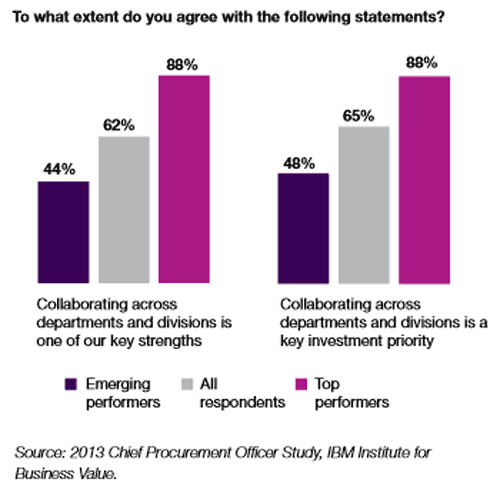The report says that "While a substantial portion of the respondents to our procurement survey use basic supply availability, cost avoidance and procurement events per FTE metrics (75 %, 68 %, and 55 % respectively), only a small number of low-performing procurement organizations use these measures (58 %, 54 %, 31 %, respectively)."
Performance dashboards for procurement are playing an increasingly important role in managing those metrics and associated performance, the report notes. So much so that 360-degree views of supplier performance and performance dashboards were the number one solution expected to add value to the enterprise in the next three years. That was followed by number 2 "Driving policy and legal compliance through reducing and standardizing clause and/or contracts," and number 3 "Methods and tools that increase the speed at which procurement transactions are executed."
Internal Collaboration is Key to Procurement Success
It is probably not a surprise, but internal collaboration between the procurement organization and other departments and groups in the company is key to overall sourcing success.
That is nicely quantified in the chart below, which shows such internal collaboration is a key strength and investment priority in top performing procurement organizations versus others, with double (88%) of top performing companies, for example, saying it was a key strength, versus just 44% for "emerging" procurement organizations.
Procurement Leaders Focus On and Invest in Internal Collaboration

"Not only will procurement perform its core mission better when it understands the needs of its internal customers, but it will also be positioned to spot untapped sources of value through improved connections with internal communities," the report notes. "Clearly, procurement can improve corporate performance in unique and powerful ways when it is plugged into a wide array of internal communities."
And like most things in supply chain these days, procurement leaders recognize the essential role people and talent play in success. For example, the data show twice as many top performers than low performers view recruiting and talent development retention as a key strength. What is more, top performers often extend these human capital advantages because they are equally aggressive in their investment plans for retention, recruiting and talent development.
What should companies that are already top performers focus on next?
The report concludes by recommending those procurement organizations should "build on their strengths by automating and applying best practices to parts of their operation that are not standardized today. They should continue to harvest innovative ideas from a wide range of sources, especially those outside the bounds of the enterprise. Finally, the top performers should make ample use of procurement analytics to trim costs and augment value."
Do you agree with the points in this IBM study? What other traits define procurement leaders? Let us know your thoughts at the Feedback button (email) or section (web form) below.

|